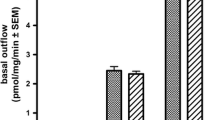Abstract
The insoluble fraction of ox-brain, which had previously been shown to have a non-linear affinity for Na+ and K+, was prepared. Acetylcholine (1×10−8 mol/l and 1×10−7 mol/l) reduced the affinity of the fraction for Na+ and K+ to zero, while at 1×10−6 mol/l, the affinity for the cations was almost as high as in the absence of the transmitter; the affinities for Na+ and K+ were particularly high, when the supernatant concentrations of these ions exceeded 80–100 mM. Addition of eserine (3×10−5 mol/l) considerably modified the response of the fraction to acetylcholine (1×10−5 mol/l). Atropine (1×10−8 mol/l) in the absence or presence of acetylcholine (1×10−5, or 1×10−4 mol/l) reduced the affinity of the fraction for Na+ and K+ to zero. Epinephrine (3×10−10 mol/l) lowered the affinity for Na+ and K+, while ergotamine itself (1×10−5 mol/l) reduced it to zero. The addition of both epinephrine and ergotamine at the latter concentrations restored the affinity of the fractions for Na+ and K+ to what it had been in the absence of the transmitter or antagonist, previously reported. Norepinephrine (3×10−10 mol/l), or ouabain (1×10−7 mol/l) reduced the affinity of the fraction for Na+ and K+ to zero. Thus, the transmitters and antagonists altered the affinity of the insoluble fraction for Na+ and K+ nonlinearity, dependent upon their concentrations, the concentrations of the cations, and the interaction of transmitter and antagonist.
Similar content being viewed by others
References
Ahmed, N. and Hillman, H. 1982. Preparation of an insoluble fraction of ox brain and its affinity for Na+ and K+. Neurochem. Res. 7:911–921.
Eccles, J. 1964. The Physiology of Synapses. Pages 49–53. Springer, Berlin.
Hillman, H. 1976. Towards a classification of the validity of experimental evidence in biology and medicine. Acta Biotheoretica 25:153–162.
Dale, H. H., Feldberg, W., and Vogt, M. 1936. Release of acetylcholine at voluntary motor nerve endings. J. Physiol. 86:353–380.
Tuček, S. 1978. Acetylcholine synthesis in neurons. Chapman and Hall, London.
McIlwain, H. 1951. Atropine and related compounds on the metabolism of electrically stimulated sections of mammalian cerebral tissues. Brit. J. Pharmacol. 6:531–539.
Polak, R. L. 1969. The influence of drugs on the uptake of acetylcholine by slices of cerebral cortex. Brit. J. Pharmacol. Chemotherap. 36, 144–152.
Montague, K. 1963. Some catechol compounds other than noradrenaline and adrenaline in brains. Biochem. J. 86:9–11.
Lewis, J. L., and McIlwain, H. 1954. Action of some ergot derivatives, mescaline and Dibenamine on metabolism of separated mammalian cerebral tissues. Biochem. J. 57:680–686.
Whittam, R. 1967. The molecular mechanism of active transport. Pages 313–325,in Quarton, G. C., Melnechuk, T. and Schmitt, F. O. (eds.) The neurosciences—a study program. Rockefeller University Press, New York.
Skou, J. C., and Nørby, J. G. (eds.) 1979. Na, K-ATPase. Structure and Kinetics. Pages 3–549, Academic Press, London.
Dixon, M., and Webb, E. C. 1964. Enzymes, Pages 422–423, 2nd edition, Longmans, London.
Author information
Authors and Affiliations
Rights and permissions
About this article
Cite this article
Ahmed, N., Hillman, H. The effects of transmitters on the affinity of the insoluble fraction of Ox brain for Na+ and K+ . Neurochem Res 14, 179–184 (1989). https://doi.org/10.1007/BF00969636
Accepted:
Issue Date:
DOI: https://doi.org/10.1007/BF00969636




